Many moons ago, in the long-distant days of 2004, historian John Guy published My Heart is My Own: The Life of Mary, Queen of Scots. It was a comprehensive biography of Mary, Queen of Scots and for some of us [read: me] it would become required reading for the various school work on Mary, Queen of Scots. In fact, it served as the subject of my university application essays. Almost fifteen years later, it was made into a film.
Given that it’s based on a work of historical fact, not fiction, you might expect the film to be historically accurate but alas! Not so. The events of the film aren’t wildly inaccurate and they follow the flow of history fairly well, albeit condensed which is common enough in films based on history. The characters however are exaggerated enough to the point where they’re charicatures of who they were in history. Their actions and reactions are often so far from what they were historically that it’s a wonder history played out the way it did.
Mary, Queen of Scots, who began her reign in Scotland politically astute, is portrayed as so eminently reasonable she can’t ever make a mistake. When she loses her crown it’s because her lords betrayed her. When she loses her life, it’s because her cousin betrayed her. Nothing is ever the result of her own actions. Meanwhile, across the border, Queen Elizabeth of England who was known to have moments of insecurity and jealousy, is shown as so unstable that the government of her country is mostly left to her advisors. Both portrayals are a little unfair as we shall see.
The latter half of the film is concerned with the Rizzio plot, the Darnley plot, and Mary’s third marriage to a man who potentially sexually assaulted her. For brevity, this piece doesn’t go into too much detail about the accuracy of these events but if you’re interested I’ve already written about them here.
Mary meet Scotland. Scotland meet Mary.
The Film: We start with some text slides giving some backstory to our heroine; Mary, Queen of Scots. As a baby, the Catholic Mary is sent from Protestant Scotland to France. At fifteen she marries the Dauphin of France but is widowed just three years later. She returns to Scotland which is being governed by her half-brother James Stuart, Earl of Moray. We also learn that England is ruled by the Protestant Elizabeth whose throne is threatened by Mary’s very existence.
We jump to 1587 where Mary is taken to a place of execution before being thrown swiftly back to 1561 where she arrives in Scotland. We are introduced to the main cast of characters. We have Mary herself, her four chief attendants (also called Mary), her brother who greets her warmly as he hands the realm over to her, and the Earl of Bothwell, Mary’s bodyguard who swore an oath to her mother to protect her. James accuses Bothwell of being driven by duty and nothing else while he loudly proclaims that there is no reason for him to be there.
In England, we are treated to the same round of introductions. We have Elizabeth attended by her ladies (Bess of Hardwick, Dorothy Stafford, and Kate Carey) but entertaining her chief advisors. She plays chess with Robert Dudley while discussing politics with Thomas Randolph, the English ambassador to Scotland, and William Cecil, her secretary of state. Elizabeth welcomes Mary’s rapprochement while Cecil claims peace between Scotland and England is impossible if Mary isn’t prepared to bend the knee and recognise Elizabeth’s sovereignty.
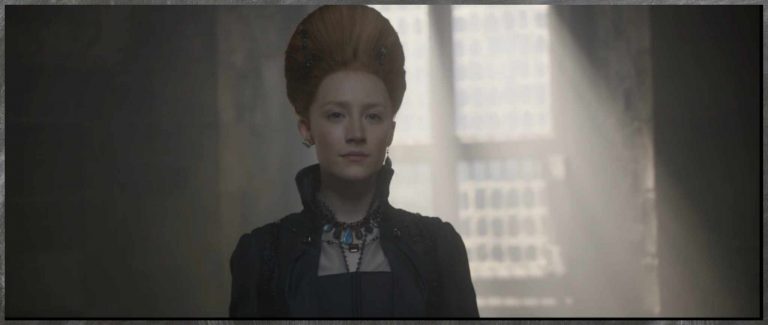
In History: As far as establishing characters goes, there isn’t much to argue with. Mary was born to the Scottish king, James V and his French wife, Mary de Guise. Six days after her birth, her father died leaving her Queen of Scotland. At five years old, she was betrothed to the Dauphin of France and was sent to live at the French court, hence the complete lack of Scottish accent.
Mary and Francis of France were married when she was fifteen and a year later, they took the French throne after the sudden death of Henry II. Their reign lasted a year and a half when Francis himself died, leaving Mary a widow with no firm position at the French court. Nine months later she returned to Scotland which had been governed in her absence by her half-brother, James Stewart, with whom she shared a father.
The introduction to Elizabeth serves to show her relationship with Dudley which was well documented and the frequent friction with her advisors. The choice of attending ladies is questionable however; Dorothy Stafford did not attain her position until three years after Mary’s return, while Bess of Hardwick spent this time imprisoned in the Tower of London despite her friendship with Elizabeth. Of the three, only Catherine Carey held a prominent position among Elizabeth’s ladies.
And then we have Bothwell. He was not Mary’s bodyguard, nor was he a quiet, unassuming gentleman driven by his devotion to duty or oaths he promised to former queens. He was brash and loud; frequently causing trouble at court and abroad. He was a prominent nobleman in his own right and played some part in Mary’s crossing from France in his position as the Lord High Admiral of Scotland. He wasn’t her bodyguard and his appearances at court were marred by quarrels with other nobles. Shortly after Mary arrived in Scotland, Bothwell spent a stint in Edinburgh prison after one such argument.
A Tale of Two Queens
The Film: We are introduced to the supporting cast of characters in our historical drama as well as the central theme of the film; the relationship between Mary and Elizabeth. In Scotland, we meet David Rizzio; Mary’s handsome and enigmatic musician/secretary who helps Mary write letters to Elizabeth. Here, she promises peace drafted by themselves and not their male subjects. She says she will recognise Elizabeth’s sovereignty on the condition that Mary is named her heir.
Back in England, Elizabeth is already jealous of Mary’s youth, beauty, and confidence. Outside her chambers, Cecil urges Robert Dudley to marry Elizabeth for the good of the kingdom but Dudley claims she will never accept him. According to Cecil, marriage to Dudley is the only way Elizabeth can secure her throne and ensure that war won’t break out when Mary bears a child of her own.
With constant parallels being drawn between Mary and Elizabeth’s positions, situations, and movements, we see Mary meeting her council as Elizabeth walks past hers. Elizabeth ignores Matthew Stewart, Earl of Lennox and his son Henry Stuart, Lord Darnley, who come to rather public blows with each other over Lennox’s loyalty to Elizabeth and not being able to return to Scotland. Mary, on the other hand, chairs her council entirely aware that as a French, Catholic woman she won’t command their support. She declares a moderate position, allowing Protestant and Catholic worship, which incurs the wrath of the misogynistic preacher John Knox who denounces her and is thrown from the Council for his trouble.
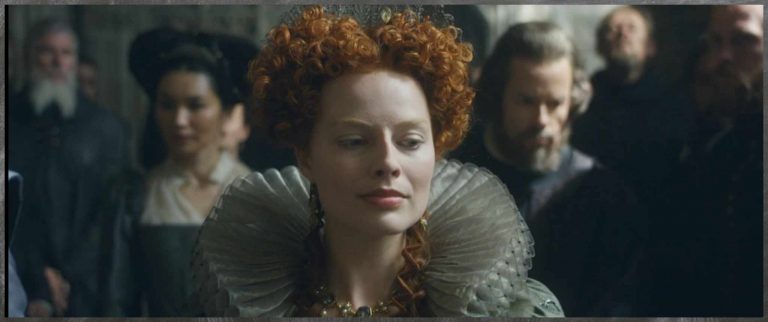
In History: Mary and Elizabeth were almost always affectionate in their letters to each other. On paper, they wanted to rule as sister-queens but in reality, they were in conflict from the beginning and not just because of their opposing religions. Mary wanted Elizabeth to recognise her as the heir to England’s throne while Elizabeth wasn’t prepared to acknowledge an heir period. From the beginning, Mary wanted to meet with Elizabeth but this was not to indulge in any curiosity when it came to her English cousin. Mary was an excellent negotiator face-to-face and in person, there was less opportunity for Elizabeth to dissemble, like she always did.
So far, the portrayal of Mary and Elizabeth hasn’t been completely fantastical, but their qualities are exaggerated to the extreme which makes it difficult to say it’s entirely accurate. Mary was moderate in her approach to politics, aware that she was effectively a stranger in Scotland despite her crown, but that didn’t extend to her being the most reasonable woman who ever lived. Likewise, Elizabeth was known to have moments of jealousy regarding Mary, but she wasn’t nearly as constantly insecure as she is portrayed here. There’s also a feeling of being brow beaten by the constant parallels.
When it came to religion, Mary did indeed propose a moderate compromise. Although a Catholic, Scotland had been Protestant for her entire life and had been governed as such. Before leaving France, she and Lord James agreed that she wouldn’t alter the state of religion and in exchange she and her household would be able to worship as they wished. On the first Sunday after Mary’s return, a group of Protestant lords tried to storm her chapel where she was hearing mass only to find their way blocked by Lord James personally. Both Mary and James were entirely committed to maintaining the status quo.
The preacher, John Knox, was one of the most prominent leaders of the Protestant movement in Scotland which saw him frequently at court and moving in the noble circles. He didn’t strictly have a place on the council, so the confrontation we see where Mary banishes Knox from court didn’t play out as shown. However, it serves as a decent amalgamation of Mary and Knox’s many encounters.
Even by the standards of a time when women were considered inferior to men, Knox was an incredible misogynist. He hated Mary’s position, her religion, and everything else about her. Even when she was promoting moderation, it was not enough for Knox who would denounce her repeatedly throughout her reign for tolerating the heretical Catholic mass amongst other things. They argued often and Mary was often left in floods of frustrated and angry tears at the obstinance of the man.
A final note for this section; William Cecil never promoted Robert Dudley’s suit for Elizabeth’s hand. While he was one of the loudest supporters of her marrying, Dudley was not his choice. He feared the relationship between the two would prove to be the end of her reign, and when speculation that they would marry reached its height, Cecil went as far as to approach Katherine Grey, Elizabeth’s cousin and potential heir, rather than support the match.
Reasons against the Earl of Leicester:
Nothing is increased by marriage to him either in riches, estimation or power.
It will be thought that the slanderous speeches of the Queen with the Earl have been true.
He shall study nothing but to enhance his own particular friends; to wealth, to offices, to lands and to offend others.
He is infamed by the death of his wife.
He is far in debt.
He is like to prove unkind or jealous of the Queen’s Majesty.
– William Cecil’s memorandum reasoning why Queen Elizabeth couldn’t marry Robert Dudley
Mary vs Elizabeth Round 1: Suitors, Succession & Smallpox
The Film: Mary continues her ‘I love Elizabeth’ routine. She is happy to marry whoever Elizabeth chooses in the interests of peace, even if it’s a Protestant Englishman. We have the first hints of an affair between Randolph and Mary’s lady-in-waiting, Mary Beaton, and affection between Scotland’s Secretary of State, William Maitland, and Mary Fleming.
While Knox denounces Mary as being a lover of the flesh, Mary teases Beaton and Fleming about their affections. She warns them of men and the difference between love and respect. She also admits that her first husband wasn’t up to much in the bedroom and that she would happily bed a man who could satisfy her. Across the border, Dudley is kissing Elizabeth in her bed but she refuses him. She plans to marry him to Mary but he only wants to marry her. Nevertheless, Dudley is dispatched to court Mary while Elizabeth takes up crafting.
Once again, Mary demands the succession in return for entertaining Dudley’s suit but would rather deal with Elizabeth in person. The two are to meet so they don’t have to go through their feeble menfolk but at the designated meeting place of York, Mary is left waiting when it’s revealed Elizabeth isn’t coming. Mary believes that this is a snub for refusing Dudley and claims that matters of the heart and matters of the state do not mix well.
Later, it is revealed to Mary Beaton through Randolph that the real reason Elizabeth isn’t there is a near-fatal bout of smallpox. Expecting the imminent announcement of Elizabeth’s death and thus proclamation of becoming Queen of England, Mary once again sends a letter demanding the succession in return for marrying Dudley. A delirious Elizabeth has a moment of grief-addled madness, accusing Mary of wanting her throne and her Robert, as she runs through the court to find him despite her permanent disfigurement from the pox. Elizabeth weeps, wondering how she is to stop the wedding that she herself suggested.
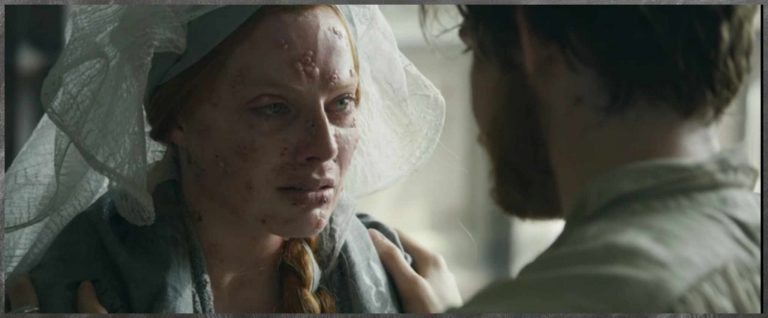
In History: At this point, we’re starting to diverge from history a bit. For a start, events are starting to be condensed. Historically, the issue of Mary’s marriage began some years after she arrived in Scotland and events didn’t move as quickly as portrayed. Quite correctly however Knox was denouncing Mary for whatever he could pin on her, Elizabeth was flirting with Dudley to excess while also contemplating marrying him off to Mary, Mary Fleming was indeed enamoured with William Maitland (and vice versa), and the English ambassador was having an affair with Mary Beaton, although historically he had no wife.
The issue of Mary’s marriage would prove hugely contentious in England. A few people, including Mary herself, observed that had one of the two queens been a man, they could have solved all their problems by marrying each other. But as that wasn’t an option Mary’s choice of groom would inevitably have repercussions in England. As such, Elizabeth demanded some oversight of the matter but if she accepted this, Mary would be recognising the seniority of the English crown over her own. Ultimately, a compromise was made utilising the prize that Mary had long been after; Elizabeth would approve Mary’s marriage and in return Mary would be recognised as the heir to the English throne. She did indeed offer Dudley as a candidate for Mary’s hand but he never personally courted Mary or visited Scotland. Nor did Elizabeth fall into such deep melancholy over the issue that she neglected the governance of the realm for scrapbooking.
The planned meeting between Mary and Elizabeth never came to fruition but not for the reasons shown in the film. They didn’t come close to meeting at York and Mary wasn’t left snubbed at the border. Instead, negotiations petered out when civil war erupted in France which brought the political differences between Mary and Elizabeth into the open. Mary, a French Catholic with French Catholic relatives found herself on the opposite side of Elizabeth who naturally supported the Protestant Huguenots. The latter went on to assassinate two of Mary’s de Guise Uncles having received financial support from Elizabeth. In light of this, the two couldn’t quite find a common ground on which to meet.
Elizabeth did indeed fall ill with smallpox however and, as in the film, it nearly killed her. But it wasn’t a secret. Elizabeth herself wrote a personal letter to Mary which referred to her illness. The English ambassador wouldn’t have been so indiscreet as to reveal private details about his queen’s health to his Scottish mistress something which could have cost him his position at the very least.
[Enter Lord Darnley Stage Left]
The Film: Dressing as a lady, Rizzio reveals to Mary that he feels more like a woman than a man. Mary accepts him for who he is and he attends her as one of her ladies might, complete with dress. The party goes out to meet the returned Earl of Lennox and his son, Lord Darnley, who immediately impresses by charming Mary.
Mary defends Elizabeth to Darnley and accuses his father of wanting the throne yet she quickly allows him to seduce her. He is later admitted to her bed with only Rizzio present as a witness. Mary says they cannot do anything that will leave her pregnant and Darnley is quite happy with this. One orgasm later, Mary is ready to marry him. The decision causes shockwaves at the English court for all except Elizabeth who is entirely happy with the decision; Darnley is an English noble exactly as she required of her cousin so what could be better?
Maitland counsels against the marriage, as does the English Privy Council. Maitland reminds her that Darnley can never be king to which Mary agrees in Darnley’s presence. Two seconds later, she’s promising him that he will be king even though he just heard otherwise. The triumphant refrain that always stops one note short of erupting into Zadok the Priest plays as Mary and Darnley confirm their marriage.
Randolph asserts to Mary that the marriage is unacceptable, Mary discards Elizabeth’s concerns, denounces her cousin as barren, and throws Randolph from court. Moray is scandalised and threatens to leave court, which Mary willingly accepts.
In England, Elizabeth reasserts that she will never marry for any husband would be naturally raised above her or be unsatisfied in his ambition. Between her and Cecil, they resolve to arm Moray and Knox in rebellion against Mary to depose her.
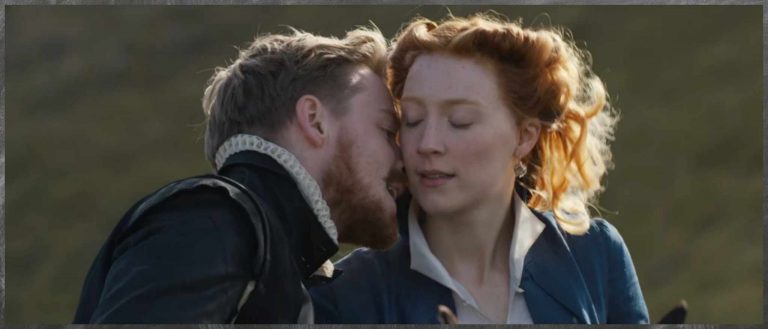
In History: Making David Rizzio transgender was certainly a progressive choice for the film and not one that is based on the historical record. An Italian musician deep in Mary’s confidences; Rizzio was an outsider at the Scottish court. It didn’t help that he was conventionally unattractive which was seen to be a reflection of his poor moral fiber. I would guess that the decision to make Rizzio identify as female was a narrative device to show his isolation at court in a way more obvious to a modern audience.
A marriage between Henry, Lord Darnley and Mary, Queen of Scots had been the subject of speculation for a long time. When her first husband died, Darnley’s mother had immediately dispatched her son to console the young widow with an eye to their marriage. On paper, they were an excellent match for everyone except the English Privy Council. Darnley himself was Mary’s cousin, a descendent of Henry VIII, and he had an excellent Scottish pedigree. On a personal level, he was Catholic, attractive, and he was one thing that Mary rarely saw; taller than her.
Historians still debate as to why Elizabeth allowed Darnley to return to the Scottish court and meet Mary, knowing that their marriage would be a nightmare. It’s been suggested that Cecil hoped to dangle both Darnley and Dudley before Mary and paralyse her into indecision. It might have just been an uncharacteristic lapse in Elizabeth’s otherwise astute policy or that her personal feelings won out and unable to part with Dudley, she sent Darnley instead. Whatever the reason, Mary was already contemplating a marriage to Darnley before she met him. After they met, it didn’t take long for her to fall hopelessly in love with him. (Likely not the result of a one-off liaison in her bed).
Mary’s decision to marry Darnley caused shockwaves throughout both courts. In Scotland, the Protestant nobles didn’t want a Catholic Englishman for their king. They had also seen a side of Darnley that Mary had not. He was spoilt, aggressive, and unstable; prone to tantrums and violence if he didn’t get his own way. Lord James was so opposed to the marriage that he left court before Mary and Darnley could overturn the positive policy he had created between Scotland and England.
In England, the Privy Council was equally outraged, as was Elizabeth. They immediately recalled Darnley and his father back to England and forbade the marriage. However, shortly before all of this happened, before Mary had made any firm decision regarding Darnley Elizabeth had written to Mary and changed their arrangement. She wrote that regardless of Mary’s marital situation, the succession would only be secured after Elizabeth married which everybody knew was not forthcoming. If Elizabeth thought this was a power move on her part it backfired quickly. In moving the goalposts, Elizabeth lost what power she had had in Mary’s marriage negotiations. Mary was now prepared to marry whoever she wanted without thought of England and Darnley ignored Elizabeth’s summons in the knowledge that fairly soon he would be far higher than an English subject. Elizabeth’s response however, was not to arm a rebellion with the intent to depose Mary.
A Wedding and A War
The Film: Mary and Darnley are married as Cecil orchestrates civil war in Scotland. Darnley gets very drunk at his wedding and it seems he’s not interested in his wife! Gasp! Instead, we see his longing glances at [drum roll please] David Rizzio. Mary discovers Rizzio and Darnley in bed together, leaving them in the care of a disgusted Bothwell before they ride out to face the rebellion.
Rizzio begs Mary’s forgiveness which she readily gives, assuring him that she knows what Darnley is like and cannot blame that he was taken in as she was. Bothwell and Mary organise the upcoming battle around Darnley who is starting to be pushed from the courtly sphere of influence. Prepared to die defending her throne, Mary marches alongside Protestants to whom she gives her blessing.
Moray by contrast cannot control his slovenly men and they fall into Mary’s ambush. It’s an easy victory for Mary though she prevents Bothwell from landing a killing blow on Moray. She’s just that merciful. Back home, buoyed by her victory, Mary tries to seduce Darnley only to find he is incapable of sleeping with her. She tells him to pretend she’s Rizzio and manages to conceive a son. Elizabeth by contrast is only fit to breed horses.
Mary reveals her pregnancy to the court, declaring her baby the heir to both kingdoms which infuriates her council and Randolph. Lennox is also unhappy as he hopes to rule Scotland through his son, who loses power when the baby is born. Elizabeth on the other hand, doesn’t care at all for the succession. She is entirely unbothered, caring only for the horses she breeds.
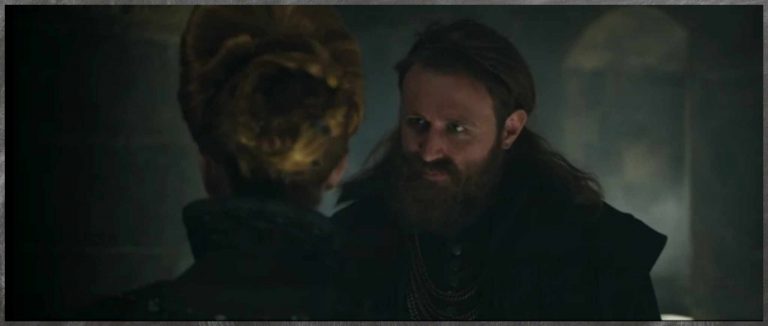
In History: James Stewart’s rebellion was not quite as dramatic as portrayed and wasn’t engineered by Cecil or Elizabeth. The rising was entirely based on Mary’s marriage to Darnley which James felt signalled a change in policy from religious moderation to full Catholicism. Neither army engaged each other and James’ forces dispersed and were defeated without having fought a single battle. James garnered little public support and even Knox came out on Mary’s side, declaring that she had never threatened Protestant worship before and was unlikely to do so now. Aware that they were hugely outnumbered by those loyal to Mary, James and his supporters fled across the border where they were roundly censured by Elizabeth for raising arms against their queen.
On a more personal note, Mary and Darnley’s marriage had indeed started deteriorating rapidly. Relations had cooled between them before they even made it to the altar but by that point, Mary couldn’t back out without a huge loss of face. She now saw the man the other nobles saw and despite her immediate insistence that he be referred to as Scotland’s King, it was clear that he was wholly unsuited to the role.
Darnley is thought to have been bisexual and he was discovered in Rizzio’s bed on numerous occasions. But the important thing to note here is the word bisexual. The producers might be progressive enough to include a trans character but not so progressive they can’t contribute to the continuing problem of bi-erasure in history. Darnley had relations with both men and women; the fact that he had one didn’t negate the other, and however many times he was found in Rizzio’s bed, he was also found in his wife’s. There’s no suggestion that fathering a child with Mary was a hardship for him. If anything, it was Mary’s increasing dislike of her husband that kept him from her bed.
The Rizzio Plot
The Film: Relations between Mary and Darnley continue to deteriorate while Moray and Lennox join forces to remove Mary from power and rule through Darnley. Knox joins in, accusing Mary of carrying Rizzio’s bastard which Maitland and the other councillors use to persuade Darnley to join their plot. During the argument, Lennox reveals that Darnley is gay which prompts Darnley to commit to the cause.
The lords then storm Mary’s chamber and murder Rizzio in front of the queen. Darnley tries to back out but is forced to make the killing blow. Bothwell manages to escape and Mary denounces Maitland, Darnley, and the others as traitors. As his conspirators make plans around him, Darnley is allowed to remain with Mary who convinces him that they need to escape.
They successfully find their way to Mary’s supporters but then Mary has Bothwell arrest Darnley and he is sent to live separately from his wife. Realising they’ve been outmanoeuvred, Moray makes peace with Mary on behalf of the council in return for proof of her husband’s involvement in the plot to kill Rizzio. Mary and Moray reconcile personally with Mary naming her imminent son for him which causes many tears.
Elizabeth, however, doesn’t care. The only thing she’s interested in is paper crafting. She refuses to meet with the council or ambassadors, instead destroying craft project after project for not being perfect enough.
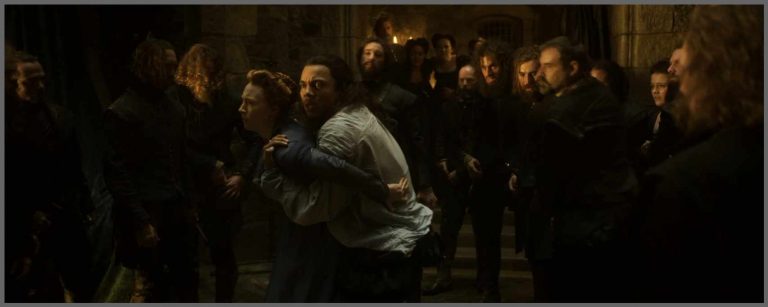
In History: The Rizzio plot was one of the defining moments of Mary’s reign and is fairly accurate in its portrayal. The unpopular Rizzio had become a polarising scapegoat within the Scottish court. A plot was devised that would remove Rizzio and bring Mary under the control of her Privy Councillors. Darnley, who had started his marriage with recognition of his kingship and was now largely ignored by Mary, already blamed Rizzio for the distance between them. He was easily persuaded into backing the plot which would see him formally recognised as King of Scotland.
Darnley and a couple of other lords entered Mary’s chambers where she was entertaining a small party, including Rizzio, via a private staircase that adjoined Darnley’s rooms. After a brief confrontation, Rizzio was attacked and stabbed multiple times before he was dragged onto the staircase and stabbed some more. In the face of the violence of the situation, Darnley tried to back out of it, but knowing that they needed Darnley’s explicit support to justify the assault, the lords took his dagger and left it in Rizzio’s body.
Mary convinced Darnley that they were in danger and the rebels had no intent of delivering on their promises of power. The two escaped and reunited with Bothwell and Mary’s other supporters where they were the queen was able to re-establish her power and the rebellion fell through. Her brother, James, now Earl of Moray, returned to court but Mary never reconciled with Darnley. She felt her life and that of her unborn child had been threatened during Rizzio’s murder which she could never forgive him for.
In England, Elizabeth was still heavily invested in the Scottish political situation. In her almost fifty-year reign, there were only a handful of times when she isolated herself. On those occasions, it wasn’t because she was disinterested or fancied improving her crafting talents; they were times of incredible personal stress and the intrigues with Scotland were not among them.
Just a reminder, you can read more about these events and those that follow in more detail here.
Heir and Exile
The Film: Mary attempts to reconcile with Elizabeth by inviting her to be her son’s godmother. She goes into labour and is delivered of the son she’d hoped for. Elizabeth accepts but is still crafting. She is also entirely happy to secure the succession on Mary which provokes her councillors. She points out that Mary has outwitted all of her male councillors at every opportunity which proves her deservedness for the throne.
Darnley lives in his new home with his male lover while the Council try to persuade Mary into a divorce. When they fail, Maitland and the councillors bring Bothwell into a new plot. Soon after, Darnley’s home explodes and he is strangled as he tries to escape. Bothwell takes Mary to his lands to secure her safety having told her that her husband is dead. That same night, he tells her that the council requires them to marry and he rapes her to secure the offer.
Mary is forced into marriage before the council and within days that same council is supporting Knox in his latest denunciation; Mary is a whore who murdered her husband to marry her lover. Bothwell is shocked to discover that the men who engineered to put him on the throne now require Mary to abdicate and she berates him for believing in them. She disowns her brother and refuses to abdicate.
Elizabeth bemoans Mary’s fate and scorns the cruelty of men as a sister queen is deposed and can never be her heir. Moray takes the throne on behalf of Mary’s son, James, as Mary flees to England.
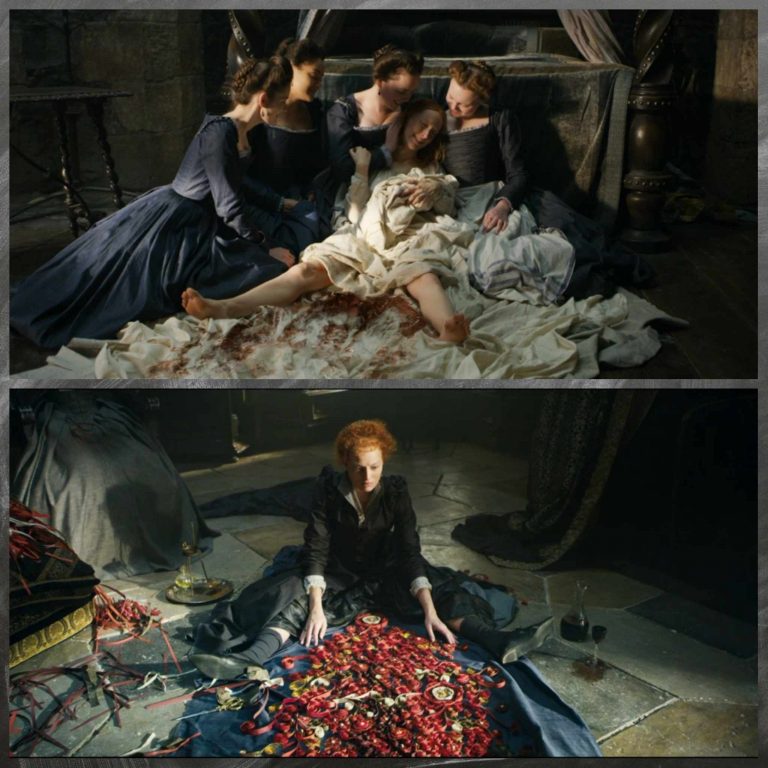
In History: It was common practice for royals to stand in as godparents for other royals. In the case of baby James, it made perfect sense to invite Elizabeth to fulfil that role; she was the queen of the neighbouring kingdom, she was his mother’s first cousin, and from the moment of his birth, James was the strongest candidate as England’s heir presumptive. It was not, however, a moment that reconciled the two queens to the point that Elizabeth was prepared to recognise Mary as her heir. At no point during her reign was she prepared to do so, fearing that if she did it would invite rebellion from her dissatisfied Catholic subjects.
While many of the events of the film are condensed into a short time frame for the sake of viewership, the assassination of Darnley and Mary’s subsequent downfall happened in an incredibly short amount of time. After the Rizzio plot, Mary and Darnley remained separated emotionally, if not physically. Their time apart was brief because Mary feared his plots against her rather than a longing for his company. While he underwent a mercury treatment for syphilis, Mary approached him and easily convinced him that they should be reconciled. He was moved to Kirk o’ Field House in Edinburgh (not with his male lover) where Mary was lodged in the rooms above him.
On the 9th February 1567, Mary visited her husband before she left to attend a wedding and that evening, the tower in which they were staying exploded. Darnley’s body was found in the gardens beyond the tower bearing obvious signs of strangulation. The plot was largely Bothwell’s with the rest of the court drawn into it and with Darnley dead, he now embarked on the second part of the plot; marrying Mary.
The film portrays Bothwell as being drawn into the scheme which goes against his good and dutiful nature. Meanwhile, Mary is a hapless victim drawn into the malicious machinations of her councillors. In reality, many of the councillors had been bullied by Bothwell into their involvement. To make matters worse, Mary made several poor decisions when it came to dealing with Bothwell and the accusations against him in that… she didn’t. In spite of the evidence and claims against him he remained at court and at liberty. Marrying him was the worst possible thing she could do in terms of public opinion but it didn’t stop her.
The loss of support was swift and brutal. The lords who had previously supported Bothwell’s bid for the throne now turned on him but not because it no longer suited them to support someone who until now had been their pawn. Bothwell had become unbearable and Mary’s marriage to him was completely untenable. After a brief conflict which saw no actual battles, Bothwell and Mary were abandoned by her army and she was forced to abdicate.
Elizabeth’s outrage at the treatment of a fellow queen was short-lived and quickly overcome with the political repercussions where she suggested that she might be granted wardship of the new king James. The French royals had the same concerns. As far as the world was concerned; Mary had acted foolishly and against all the good advice from her friends (and her enemies) and was now facing the consequences. Attention was now solely on her son.
Mary vs Elizabeth Round 2: The Road to Fotheringaye
The Film: Having escaped to England, Mary and Elizabeth meet in secret. While they talk, Elizabeth refuses to show her face, still terrified of Mary’s beauty. Elizabeth offers Mary her protection but she cannot raise an army to declare war on Scotland. They argue as Mary begs for help to regain her throne while Elizabeth can only promise safety. Mary asks her to believe in the two of them as sister queens rather than the men who counsel her but Elizabeth reveals she has become more than man than woman.
In response, Mary goes off. She says that her claim to England’s throne is stronger than Elizabeth’s but Elizabeth stops her, revealing that she was so jealous of Mary and everything she had. But now she sees that she has no reason to be because everything she was envious of has brought Mary down. She finalises her offer of protection but Mary believes Elizabeth will have her killed before long. When Elizabeth assures her Mary’s fate is in her own hands, Mary assures her she is being pushed towards Elizabeth’s enemies and it’s Elizabeth’s fault.
We then return to the beginning of the film. This time, Mary’s journey to the block is narrated by Elizabeth who reveals Mary’s supposed treason. Even though she knows the letters that condemn her might not be in Mary’s hand she has to execute her. She also reveals how changed she is, having sacrificed her womanhood for the sake of the throne. She remembers Mary as beautiful and confesses how she has always admired her.
Mary is taken to the block where she takes off her coat to reveal a bright red dress, the colour of martyrdom. Mary speaks to the camera/her son content that James will unite both kingdoms. As she lays her head on the block, she whispers that at that point, at last, “we shall have peace.”
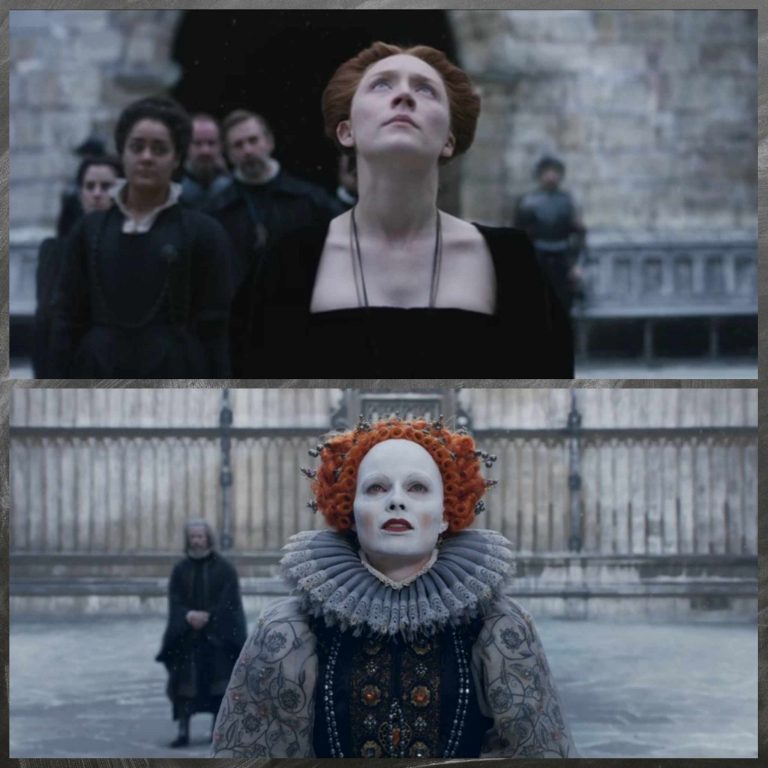
In History: It’s a common theme in fiction dealing with Mary and Elizabeth to imagine what might have happened if they had met. The truth is that they never did, even during Mary’s long imprisonment under Elizabeth. We know that there was no secret meeting either, simply because the logistics required to move the queen would have left a record, even a vague one. We can take this finale for what it is; the culmination of the film’s themes through the ultimate confrontation between the two queens. Cinematically, anything less would have been a disappointment.
Once again, their known qualities are exaggerated. Elizabeth was known to be a jealous woman and dealing with Mary brought out some of the worst examples of that. The insecurities that led to her wearing a wig and plastering her face in white paste had almost nothing to do with Mary and everything to do with how she feared public perception after the disfigurement of smallpox. But that probably wouldn’t have extended to tearfully breaking down in front of Mary as she realises that she doesn’t need to be beautiful etc.
In the same vein, Mary was surprised to learn that Elizabeth wasn’t prepared to help her regain her throne at the head of an army but that wouldn’t have extended to denouncing the latter’s claim to her throne and openly preparing to commit treason against her. Neither of them were expecting Mary to remain in England for as long as she ultimately would so neither made particularly apt prophecies regarding Mary’s future plots to regain her freedom.
There have been centuries of debate over how involved Mary had been in the various plots devised to either set her free and/or depose Elizabeth. We aren’t going to solve them here but suffice to say Elizabeth refused again and again to have her cousin tried and executed even in the face of her council and parliament. When Mary was eventually executed, it was done so possibly without Elizabeth’s knowledge. She signed the death warrant in secret but entrusted it to a minor member of the Privy Council. Later, when the council took it upon themselves to act upon it, Elizabeth had some deniability and an easy scapegoat in the councillor. Regardless, Mary’s death was not something that Elizabeth undertook lightly.
The confrontation comes down to Elizabeth rejecting her femininity to rule as a man vs Mary who wants to rule as a woman fully. Historically, this has some merit but the way its presented is a little on the nose. Mary wasn’t a hapless victim of a male-dominated world while Elizabeth didn’t become a repressed masculine creature, incapable of feeling. The truth, as it so often is, is somewhere in the middle.
They were both rulers at a time when women weren’t considered capable of fulfilling that role. Mary acted as a woman was expected to; she married and had children and was praised for it. When her council took against her, it was the easiest thing in the world to blame her natural, feminine weakness. The alternative was to act as Elizabeth did. Elizabeth often described herself using masculine language, calling herself a “prince” or “king” but she never saw herself as a man. The belief that women were unsuited to rule was not so superficial that it could be so easily circumvented by a queen reinventing herself as a king. If anything, she was seen as unnatural for going against her own nature.
Mary was hated for being a woman and Elizabeth was hated for not being woman enough. One fundamental thing they had in common, as they’ve had with women throughout history regardless of position, is that they simply couldn’t win.
That’s it for 2023 folks! I’ll be back in the New Year to fact check more fun shows. In the meantime, I hope you all enjoy the holiday season and as ever, you can join me behind the scenes at my Patreon.












